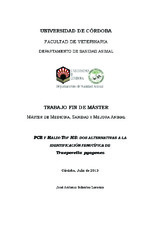PCR y MALDI-TOF MS: dos alternativas a la identificación fenotípica de Trueperella pyogenes
Autor
Infantes Lorenzo, José Antonio
Director/es
Borge-Rodríguez, CarmenEditor
Universidad de CórdobaFecha
2015Materia
Trueperella pyogenesIdentificación molecular
MALDI-TOF MS
METS:
Mostrar el registro METSPREMIS:
Mostrar el registro PREMISMetadatos
Mostrar el registro completo del ítemResumen
En nuestro estudio hemos realizado la identificación fenotípica, genética y
proteómica de un total de 70 cepas de origen porcino aisladas a partir de lesiones de
carácter supurativo, a las que se les había realizado una caracterización previa en
base a sus características morfológicas, hemolíticas y serológicas como la reacción de
aglutinación con el antisuero frente al grupo G de Lancefield.
La caracterización fenotípica se llevó a cabo mediante el sistema comercial API
Coryne 2.0 (software de lectura Apiweb V 3.0) que identificó 67 cepas como Trueperella
pyogenes con perfiles bioquímicos variables, dos cepas como Arcanobacterium
haemolyticum y una cepa como Microbacterium spp.
Para la identificación genética se emplearon técnicas de PCR convencional: la
amplificación del gen plo sirvió para la caracterización de los aislamientos de T.
pyogenes, mientras que la amplificación del gen aln se utilizó en el caso de A.
haemolyticum. Las 67 cepas identificadas mediante API Coryne como T. pyogenes
fueron plo+, mientras que en el resto no pudo determinarse la presencia del gen. El
gen aln, no fue amplificado en ninguna de los aislamientos estudiados, estando este
resultado en discordancia con el obtenido mediante el sistema API Coryne.
Por último, el estudio proteómico se realizó con el sistema MALDI-TOF MS
(Matrix-assisted laser desorption ionization-time of flight mass spectrometry) que se
reveló como una técnica válida para la identificación rutinaria de las cepas de
T. pyogenes a un nivel similar a las técnicas de PCR. In our study we have performed the phenotypic, genetic and proteomic
identification of a total of 70 bacterial porcine strains isolated from suppurative
lesions, which were previously characterized based on their morphological, hemolytic
and serologic characteristics as the agglutination reaction with the antiserum against
Lancefield G group.
The phenotypic characterization was carried out by using the commercial
system API Coryne 2.0 (apiweb reading software V 3.0), identifying 67 strains as
Trueperella pyogenes with variable biochemical profiles, two strains as
Arcanobacterium haemolyticum and one strain as Microbacterium spp.
For the genetic identification, conventional PCR techniques were used: the plo
gene amplification was used for the characterization of T. pyogenes isolates, while the
aln gene amplification was used in the case of A. haemolyticum. The 67 strains
identified by API Coryne as T. pyogenes were plo+, while the presence of this gene was
not found in the rest of the strains. The Aln gene was not amplified in any of the
studied isolates, being this result in disagreement with that obtained with the API
Coryne system.
Finally, the proteomic study was performed by using MALDI-TOF MS (Matrixassisted
laser desorption ionization-time of flight mass spectrometry), which was
demonstrated as a valid method for the routine identification of T. pyogenes strains,
with similar results to those obtained by means of PCR techniques.
Descripción
Premio extraordinario de Trabajo Fin de Máster curso 2012-2013. Medicina, Sanidad y Mejora Animal.

